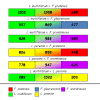Development and mapping of DArT markers within the Festuca - Lolium complex
- PMID: 19832973
- PMCID: PMC2770082
- DOI: 10.1186/1471-2164-10-473
Development and mapping of DArT markers within the Festuca - Lolium complex
Abstract
Background: Grasses are among the most important and widely cultivated plants on Earth. They provide high quality fodder for livestock, are used for turf and amenity purposes, and play a fundamental role in environment protection. Among cultivated grasses, species within the Festuca-Lolium complex predominate, especially in temperate regions. To facilitate high-throughput genome profiling and genetic mapping within the complex, we have developed a Diversity Arrays Technology (DArT) array for five grass species: F. pratensis, F. arundinacea, F. glaucescens, L. perenne and L. multiflorum.
Results: The DArTFest array contains 7680 probes derived from methyl-filtered genomic representations. In a first marker discovery experiment performed on 40 genotypes from each species (with the exception of F. glaucescens for which only 7 genotypes were used), we identified 3884 polymorphic markers. The number of DArT markers identified in every single genotype varied from 821 to 1852. To test the usefulness of DArTFest array for physical mapping, DArT markers were assigned to each of the seven chromosomes of F. pratensis using single chromosome substitution lines while recombinants of F. pratensis chromosome 3 were used to allocate the markers to seven chromosome bins.
Conclusion: The resources developed in this project will facilitate the development of genetic maps in Festuca and Lolium, the analysis on genetic diversity, and the monitoring of the genomic constitution of the Festuca x Lolium hybrids. They will also enable marker-assisted selection for multiple traits or for specific genome regions.
Figures




Similar articles
-
Genetic mapping of DArT markers in the Festuca-Lolium complex and their use in freezing tolerance association analysis.Theor Appl Genet. 2011 Apr;122(6):1133-47. doi: 10.1007/s00122-010-1518-z. Epub 2011 Jan 7. Theor Appl Genet. 2011. PMID: 21212931
-
Genomic constitution of Festuca × Lolium hybrids revealed by the DArTFest array.Theor Appl Genet. 2011 Feb;122(2):355-63. doi: 10.1007/s00122-010-1451-1. Epub 2010 Sep 25. Theor Appl Genet. 2011. PMID: 20872131
-
A DArT marker genetic map of perennial ryegrass (Lolium perenne L.) integrated with detailed comparative mapping information; comparison with existing DArT marker genetic maps of Lolium perenne, L. multiflorum and Festuca pratensis.BMC Genomics. 2013 Jul 3;14:437. doi: 10.1186/1471-2164-14-437. BMC Genomics. 2013. PMID: 23819624 Free PMC article.
-
Cytogenetics of Festulolium (Festuca x Lolium hybrids).Cytogenet Genome Res. 2008;120(3-4):370-83. doi: 10.1159/000121086. Epub 2008 May 23. Cytogenet Genome Res. 2008. PMID: 18504366 Review.
-
A decade of "chromosome painting" in Lolium and Festuca.Cytogenet Genome Res. 2005;109(1-3):393-9. doi: 10.1159/000082425. Cytogenet Genome Res. 2005. PMID: 15753602 Review.
Cited by
-
Molecular characterisation and interpretation of genetic diversity within globally distributed germplasm collections of tall fescue (Festuca arundinacea Schreb.) and meadow fescue (F. pratensis Huds.).Theor Appl Genet. 2012 Apr;124(6):1127-37. doi: 10.1007/s00122-011-1774-6. Epub 2012 Jan 6. Theor Appl Genet. 2012. PMID: 22222441
-
Genetic mapping of DArT markers in the Festuca-Lolium complex and their use in freezing tolerance association analysis.Theor Appl Genet. 2011 Apr;122(6):1133-47. doi: 10.1007/s00122-010-1518-z. Epub 2011 Jan 7. Theor Appl Genet. 2011. PMID: 21212931
-
Cytogenetic and molecular genotyping in the allotetraploid Festuca pratensis × Lolium perenne hybrids.BMC Genomics. 2019 May 14;20(1):367. doi: 10.1186/s12864-019-5766-2. BMC Genomics. 2019. PMID: 31088367 Free PMC article.
-
Genome-wide SNP identification in multiple morphotypes of allohexaploid tall fescue (Festuca arundinacea Schreb).BMC Genomics. 2012 Jun 6;13:219. doi: 10.1186/1471-2164-13-219. BMC Genomics. 2012. PMID: 22672128 Free PMC article.
-
Genomic constitution of Festuca × Lolium hybrids revealed by the DArTFest array.Theor Appl Genet. 2011 Feb;122(2):355-63. doi: 10.1007/s00122-010-1451-1. Epub 2010 Sep 25. Theor Appl Genet. 2011. PMID: 20872131
References
-
- Jauhar J. Cytogenetics of the Festuca-Lolium complex Relevance to Breeding. Berlin: Springer-Verlag; 1993.
-
- Hackel E. Monographia Festucarum Europearum. Theodor Fischer, Kassel et al Berlin; 1882.
-
- Clayton W, Renvoize S. Genera Graminum: Grasses of the World. Kew Bull. 1986;Add Ser 13:1–389.
-
- Darbyshire SJ. Realignment of Festuca subgen Schedonorus with the genus Lolium (Poaceae) Novon. 1993;3:239–343. doi: 10.2307/3391460. - DOI
Publication types
MeSH terms
Substances
LinkOut - more resources
Full Text Sources
Molecular Biology Databases

